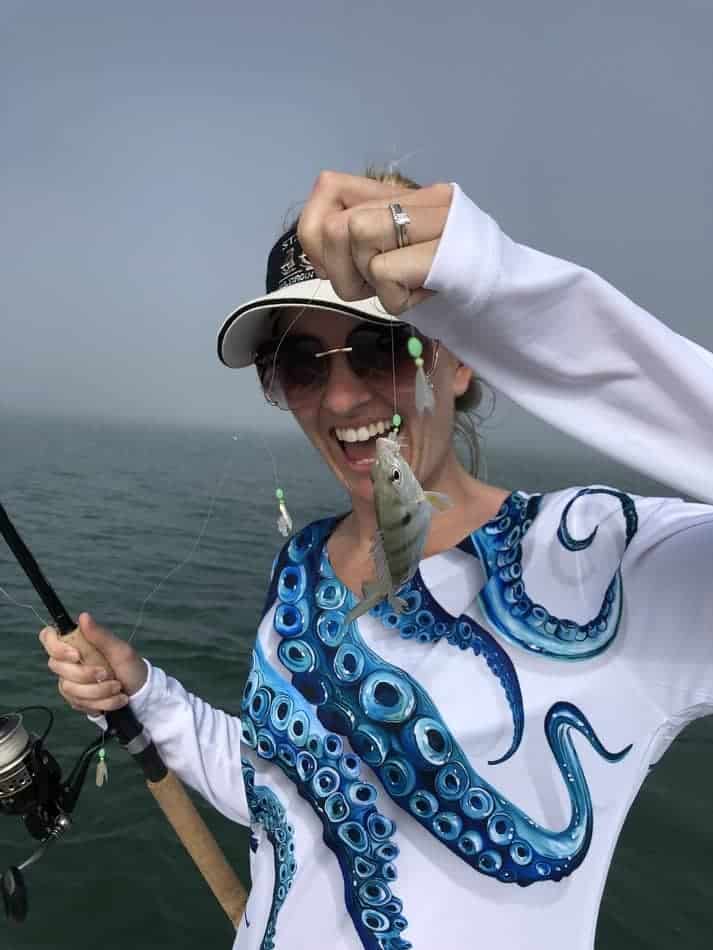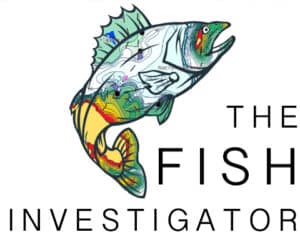
Pinfish are one of the most popular baitfish used to target large predator fish. Let’s take a look at how to catch Pinfish while also learning more about the species as a whole.
How To Catch Pinfish
Pinfish are caught on shallow water structures including grass flats, mangroves, and oyster bars by hook and line, cast net, or trapping.
Let’s take a look closer look at the various methods of catching Pinfish.
Catching Pinfish With A-Rod And Reel
The first and most popular method of catching Pinfish is using a rod and reel, commonly referred to as the hook and line method. This method of catching Pinfish is a fun and easy way of catching them and typically yields the largest specimens, which are great for targeting larger predator fish.
Use light tackle and fish in shallow water. I have always had the best success fishing 10lb fluorocarbon on a #6 to #8 sized J hook. Use a single hook outfitted with a small ⅛ to ¼ ounce weight. You can either cast and wait, jig, or simply drag your bait along the bottom with a slow retrieval. The most productive retrieval is always a slow retrieval with random dramatic jigs. This retrieval method is by far the most successful because Pinfish live inside seagrass beds, and every time you jig your bait, it rises slightly above the grass line and then falls slowly back into the grass bed. You will notice that Pinfish almost always hit the bait on the fall. Pinfish love this retrieval method because it does not require them to venture far from their cover to grab an easy meal.
Pinfish can be caught using various baits, including shrimp, squid, and chunk baits. Personally, I have always noticed that small cuts of shrimp have worked best.
Some anglers prefer targeting Pinfish with a Sabiki Rig, which is simply a fishing rig with multiple hooks decorated to resemble small baitfish. Sabiki rigs are a great option when fishing deeper structures like channel markers or docks. Deeper structures are often fished vertically rather than horizontally, which is ideal when using Sabakis to limit snags that would otherwise occur if fishing vertically.
Expert Tips On Catching Pinfish On A Rod And Reel
- Tipping your Sabaki: When fishing with a Sabaki Rig, you can dramatically increase your success by tipping your Sabaki with tiny pieces of shrimp or squid. By tipping the Sabiki, you add extra scent to the rig, which is one of the main ways Pinfish locate their next meal.
- Use light tackle: Pinfish can be easily spooked if your fishing tackle is too heavy. Always err on the side of too light.
- Find moving water: Pinfish rarely go out and search for food; rather, they remain stationary in their structure and wait for the moving water to bring food to them. Because of this feeding strategy, Pinfish are most actively feeding when the tides are moving.
- Find the salty water: Though Pinfish can be found in brackish water, they prefer waters that are higher in salinity. When targeting Pinfish, you will always have greater success fishing waters closer to the open ocean where salinity and water quality levels are much higher.
- Fish grass flat ledges: If you can locate small ledges on grass flats, you can be confident you are in Pinfish city. If you find one of these ledges, anchor your boat so you to cast and retrieve your bait along the ledge.
Catching Pinfish Using A Cast Net
One of the easiest and quickest ways of catching a large quantity of Pinfish is using a cast net. Many anglers simply make a blind cast into the water in hopes of hitting a large school of Pinfish. Though this method can be productive, it also can be exhausting and yield little to no results. There is a better way!
Here Are My Top 5 Tips On Catching Pinfish Using a Cast Net
- Look for flashes in the water: Pinfish will often gather in large schools as they feed; as the light bounces off their scales, it creates the appearance of a “flash” in the water.
- Chum them up: If you feel lazy or just don’t want to waste any time, the quickest way to get Pinfish to come to you is to chum the water. The best way to do this is to anchor up-current and sprinkle dry chum off the back of the boat. After five or so minutes have passed, throw your net directly on top of the chum line you have created.
- Using the correct mesh size: Pinfish are an extremely fast baitfish often known to escape the cast net if you are using the wrong sized mesh. As you can imagine, the larger the mesh size, the quicker the net will sink. Because of this, it is recommended to increase your mesh size as you go into deeper water. I typically use a ⅜” mesh for grass flats and a ¼” mesh for waters exceeding 5 feet.
- Find them before you cast: If you have been fishing the backwaters for any period of time, you probably already know that Pinfish love to nibble off the tips of paddle tail lures. We use this to our advantage by casting our lures on the grass flats and retrieving them just above the grass line, taking note of any small stikes. If you get multiple bits while retrieving your lure, you’ve found the school, and you better be ready to cast your net in the water.
- Find the birds: Birds are often synonymous with the presence of Pinfish. If you can locate birds congregating on the grass flats, you can be confident you are in Pinfish territory.
Catching Pinfish Using a Pinfish Trap
The last method and by far the most passive method of catching Pinfish is using a Pinfish trap. Traps are a great way to catch large quantities of Pinfish, especially if you have the time to plan ahead.
Pinfish traps are built with a chum compartment that is best when filled with fresh chum, either homemade or store-bought. The chum takes a while to attract large schools of Pinfish, so it is best to give your trap a minimum of 2 hours but do not exceed 24 hours, or you will risk the chance of killing the Pinfish in the trap.
Top Baits For Catching Pinfish
- Cut shrimp
- Cut squid
- Chunked bait (various species)
Using Artificial Lures For Pinfish
Here are a couple of artificial lures that may come in handy next time you can’t get bait.
- Sabakis
- Cut Gulp!
- Fish Bites
When Can You Catch Pinfish?
Pinfish can be caught year-round but are most prevalent in the fall and winter months while spawning. Pinfish can be caught throughout the day but are most actively feeding during low-light conditions, including dawn and dusk.
Where Is The Best Place to Catch Pinfish?
The best place to catch Pinfish is on a shallow grass flat that is adjacent to other structures, including docks, mangroves, & oyster bars. Though Pinfish are caught in depths up to 200 feet, they are most prevalent in 16” to 32” of water. Pinfish are found in tropical, subtropical & temperate waters.
87% of fishing charter captains stated that 16″ to 32″ was the ideal depth to target Pinfish.
independent research performed by fishinvestigator.com
Best Fishing Spots for Pinfish
- Grass flats
- Channel markers
- Docks
- Mangroves
- Oyster bars
- Various shallow water structures
Best Fishing Tackle For Catching Pinfish
Choosing the correct fishing tackle can dramatically improve your overall success in catching Pinfish out on the water.
Here are our recommendations for the best fishing tackle to catch more Pinfish:
Best Fishing Rod And Reel For Pinfish
When choosing a good rod and reel setup for Pinfish, you want something lightweight and sensitive to feel when they strike your baits. I recommend a 2000 sized reel and a lightweight rod. There is no need to break the bank for a baitfish setup so think small and reliable.
Best Line For Catching Pinfish
Pinfish are small baitfish, so there is no need for any fancy line to catch them. With that said, I always recommend using braid because it increases the overall sensitivity of your fishing setup. A good size line for targeting Pinfish is a 15lb test.
What size Leader To Use For Pinfish?
It is best to use a light leader when targeting Pinfish. I recommend using a 10lb fluorocarbon leader.
What Size Hook For Pinfish?
The best size hook for catching Pinfish is a #6 to #8 J-hook. Any smaller and the Pinfish run the risk of swallowing the hook, any larger, and they will shy away from your bait altogether.
Let’s take a deeper look at how to catch Pinfish by learning more about the species as a whole.
What are Pinfish?
Lagodon Rhomboides, commonly referred to as Pinfish, Pin Perch, Sand Perch, and Butterfish, are small saltwater fish found in tropical, subtropical, and temperate waters. Pinfish derived their common name from their dorsal fin having sharp pin-like spines that can easily harm anglers or other predator fish. Pinfish bodies are oval-shaped with a flattened appearance. Pinfish are blueish silver in color with vertical and horizontal stripes and have a distinctive black spot just behind their gill plate.
Natural Pinfish Diet
- Seagrasses (adults)
- Small shrimp
- Fish eggs
- Insect Larvae
- Worms
- Amphipods
Are Pinfish Good To Eat?
Pinfish are excellent to eat. The flesh Pinfish is white, flaky with a mild flavor profile. Though Pinfish are good eating, they are rarely harvested by anglers due to the small nature of the fish.
Are Pinfish Poisonous?
Pinfish are not Poisonous, but they should be handled with care to avoid being stabbed by their sharp dorsal fins.
Are Pinfish Related To Croaker?
Pinfish are not related to Croaker. Pinfish are in the Sparidae family, whereas Croaker are in the Sciaenidae family.
Do Pinfish Have Scales?
Pinfish have small yet hard scales that start from their gill plates and end at the base of their tails.
Do Pinfish Have Teeth?
Pinfish have incisor teeth on both their top and bottom jaws, as well two rows of molars found just behind their first set of teeth. Pinfish use their incisor teeth to rip and pull apart food and their molars to grind food into smaller particles for easier digestion.
List Of Fish You Can Catch Using Pinfish As Bait
- Snook
- Tarpon
- Snapper
- Redfish
- Black Drum
- Snapper
- Jack Crevalle
Pinfish Size & Bag Limits
Pinfish have no minimum size limit. The bag limit is 100lb per angler, so go to town!
